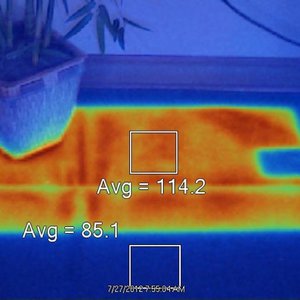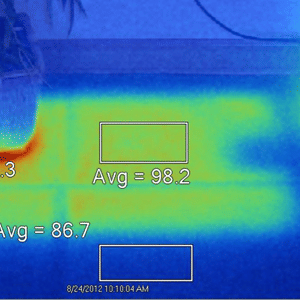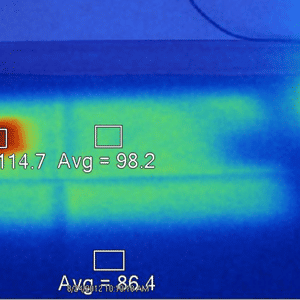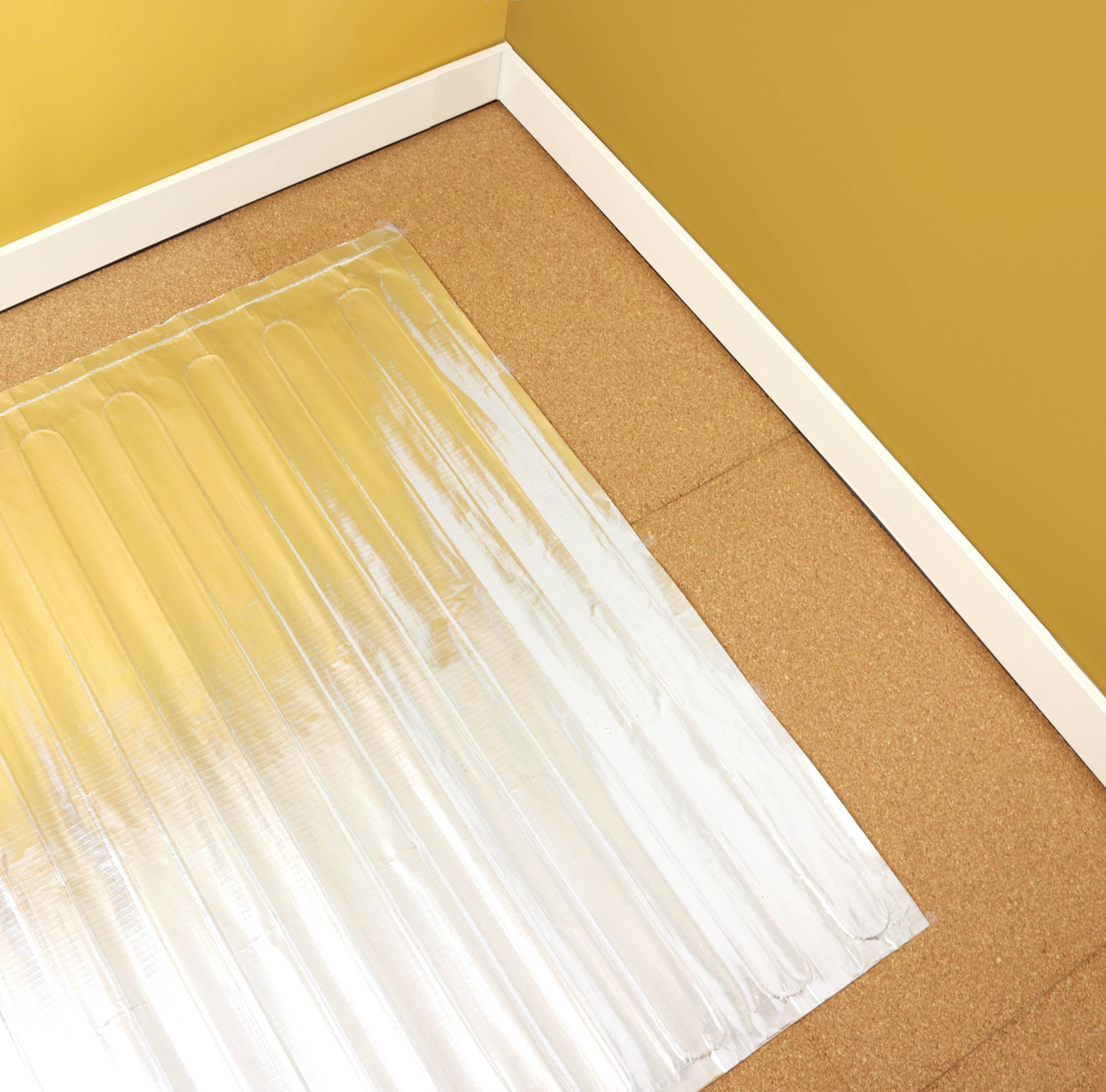Many people ask us why we recommend keeping items off a floor where radiant heat is present. Here’s why: items placed on top of the floor can trap radiant floor heat. This trapped heat can make the area much warmer than the surrounding areas. If you are not careful, in some cases, trapped heat can cause problems with the floor coverings and radiant heat system itself.
What is trapped heat?

To demonstrate this phenomenon, we took a heated mat and placed it over a laminate floor for 30 minutes.
Image 1 shows the thermal image of the floor immediately after we lifted the mat. You can see the surface temperature displayed near the illustrated boxes. The box on the top is 114 degrees, and the box on the unheated portion of the floor is 85 degrees. The deeper the red hue, the hotter the area is. Cooler areas are shown as shades of blue.

In Image 2, we can see the surface temperature is dropping, but there is still some dark red present near the base of the flowerpot where heat is trapped.
In Image 3, the flowerpot has been removed from the area. The area under the pot is still about 16 degrees warmer than the other areas that were under the heated mat.
Why is trapped heat a problem?
Trapped heat should be avoided because it can have some unwanted consequences. If the floor temperature sensor is located under the insulating item, false readings can occur. As a result, the system responds to the warmer temperatures at the sensor (under the object), and the rest of the floor will be colder than desired.
Leaving objects, like a beanbag chair, futon mattresses, boxed-bottom furniture or fixtures, in the same place on the floor for extended periods of time may result in localized areas of discolored carpet or laminate. The Environ™ radiant heating products are powered at 12 watts per square foot, which will not cause discoloration when installed and used under the conditions provided in the installation manual. However, problems can arise if excessive insulation (an object) is placed over a heated carpet area for long periods of time. Carpets that are lighter in color or lower in quality are the most vulnerable to discoloration.

Laminate, engineered wood and carpet are more forgiving than hardwood, but they all can be affected by trapped heat. Gapping, cupping, and discoloration can occur in any of these floor coverings when the heat is trapped for long periods of time. For the best results, always follow the humidity recommendations of the flooring manufacturers.
In extreme cases, trapping heat for an extended period of time can be a safety issue resulting in a system failure if the floor covering fails.
What can be done about it?
Prevention is the best strategy to avoid trapped heat. Following the recommendations in the Environ™ installation manual will ensure safe, trouble-free operation of your radiant heat system for many years.
Those recommendations for avoiding trapped heat include the following:
- • Never install radiant heat under permanent fixtures or items with flat or boxed bottoms.
- • Ensure that there is a minimum clearance of 2-3 inches between the floor covering surface and the underside of the furniture to allow free movement of air through that space for any large furniture on short legs (e.g. sofa or bed). Do not allow bedclothes or drapes to restrict the airflow under furniture.
- • The following types of furniture should never be allowed onto the surface of the carpet or other floor covering where radiant heat is installed: pianos , bookcases, closed-bottom furniture, and any stands that have sharp points as feet.
The system will work great if you let it. By following a few simple guidelines, you can enjoy the maintenance-free comfort, convenience, and other benefits of radiant heat for many years.
After all, if you just spent money on a heated floor, why cover it up and keep the heat from getting into the room? Why place a barrier between you and the heat when instead you can enjoy the open space, additional warmth, and your investment?





Your article makes me wonder if it is OK to put a yoga mat on a heated floor. My wife does a 2 hour long routine every day. Will her yoga mat trap heat and damage either the carpet or the floor heat system?
That's a great question. From the information you've provided, having a yoga mat on your floor for a couple of hours a day shouldn't pose any serious issues for your system. The use of a yoga mat might trap a small amount of heat as yoga mats typically have some degree of insulation but this shouldn't cause the system to overheat and damage itself or the carpet in just a few hours.
I want to put UFH in my conservatory with a stick down LVT floor covering. I am looking at an electric foil system with dual overlay boards on top of that, to which the LVT will be glued. I have a considerably heavy marble table on it's way which I planned to put in the centre of the room (1.8m length and approx 130-150kg (286-330lbs), and it has quite a large flat bottom/plinth type base (also made of some kind of metal; it has a chrome finish, as do the chair legs). Would this not be advisable to put on UFH? If not, are there any other recommendations for what I could do in this siutation? I really want UFH so I can make the conservatory habitable all year round, but I am also worried the floor would practically melt or something equally horrific with this table on top and no airflow under the plinth!
That's a great question and a very unique project! We'd actually recommend that you use an embedded heating system with your LVT flooring, so something like our TempZone Flex Rolls or Cables which are embedded in self-leveling cement. Then the LVT flooring can be glued down to that now perfectly flat surface. This helps to prevent the LVT flooring from conforming to the heating element wires once the wires heat up the pliable material (which can happen with relatively thin LVT). Secondly, to avoid "trapped heat", we could design a heating system for your room that wouldn't put any heating elements in the area around the base of the table. This not only avoids the trapped heat issue but it also cuts down a little bit on material and operational costs. At the size/weight you mentioned, you probably won't be moving the table very often, so we'd treat it as a permanent fixture.
Hi , I want to put in a heated floor system in my kitchen , which is also my back entrance. This entrance is used regularly and would require a carpet in the winter months. I have two possibilities, the first is a new wood product, which is waterproof, heat resistant and compatible with a heated flooring system. That being said, since have been reading about the use of carpet with underfloor systems , I’m skeptical. I could also just lay tile in the kitchen, which was the original plan. From what I’m understand, a small carpet on top of the tile is not as problematic. Thanks for your help!
From what you've outlined, it shouldn't be a big issue to use a small carpet on top of the tile floor but keep in mind that carpet carpets or area rugs thicker than 3/4” should be avoided, as they act as an insulator over the heated area, reducing the efficiency of the installation. Hope that helps!
I have a client who we putting in a UFH system under tile in a kitchen and want to put a pedestal based dining table, flat to the floor, will this create an issue?
That shouldn't be an issue as long as we design the heating system around that pedestal base (we'd essentially treat it as a permanent fixture during the design process). We'd design a heating system that omitted the area where the table would be placed to avoid trapped heat. Give us a call at 1-800-875-5285 and we can walk you through the process!
I have heated flooring with tile. Can animal skins used as rugs or will the backing cause trouble?
Our general guideline is to avoid any rugs that are thicker than 3/4" as this could cause trapped heat. Another important consideration is the thermal resistance of the rug (or animal skin). The higher the r-value (a measurement of thermal resistance) the greater the chance of that material trapping heat. Hope that helps!
Hi, What happens if I leave a matress on the heated floor for 5 months? Someone will probably slep there for the period. Thanks
Leaving just a mattress on a heated floor will result in "trapped heat" which can cause the portions of the floor heating system directly under the mattress to potentially overheat which can negatively impact the heating systems ability to function properly. We do recommend the use of a bed frame with a clearance of at least 2" to 3" to avoid the problem of trapped heat. Hope that helps!
I’m in a argument with my girlfriend about leaving piles of clothes all over the floor. I told her the reason our room doesn’t heat well is because of all said clothes… she seems to think that isn’t the case. I mean I walk over pick up clothes and they are warm. One would think that’s self explanatory, unless I’m really wrong
It's impossible for us to say for certain that it's the only (or even primary) issue you're encountering issues with your radiant heating system, however, we have certainly had clients report in the past that clothes on the floor (particularly in multiple layer piles) have caused "trapped heat" which in turn can limit the effectiveness of a floor heating system. It's the same functionality as an area rug or a dog bed or anything that "traps heat" that is laying directly on the heated floor without any clearance. Usually all it takes to resolve this issue is simply to remove the items trapping the heat from on top of the floor. Hope that helps!
Hi, would it be OK to have a canvas laundry hamper on the heated tile floor? The hamper would not be on the sensor. Thanks!
Thanks for the very interesting question! While you shouldn't have to worry about the sensor getting an inaccurate read or the tile floor discoloring, this is still something we would recommend you avoid because of the hamper itself. There's the possibility that the dyes and chemicals in the hamper and/or its contents could become discolored from sustained direct contact with the heated floor (this isn't super likely in our experience but something to avoid risking if you can). However, if you can get the hamper of the ground by placing it on a stand or a frame with legs/casters with a couple of inches of clearance underneath, then you shouldn't have any issues. Hope this helps!
Hi If I’m putting heated floor in my kitchen under porcelain tiles is it ok to have it under a standard kitchen table with 4 legs in corners
Thanks for reading and submitting a question! A standard kitchen table shouldn't be a problem at all in regards to trapping heat. Hope that helps!
Hello, I am building a garden room and dry underfloor heating is the plan. The intention is for my wife to teach pilates (similar to Yoga) and there will likely be a good proportion of the room covered by Pilates mats (10mm foam or PVC). Would the heat not just come through the mats and heat the persons lying on them or could these mats cause the heating system to fail with trapped heat?
Thanks for reading and for submitting a question. As long as the mats aren't left in place permanently, then you shouldn't have any significant issues with trapped heat but it's hard to say definitively. We have had customers use our products in yoga studios with very positive results so we're hopeful the same will be true for your pilates space. Hope that helps!
Important to distinguish between ELECTRIC and HYDRONIC in-floor radiant systems. Electric systems have heating elements that can approach 180°f, and therefore the surface of the floor could theoretically approach 180°f if it were perfectly insulated (by a stack of mattresses, say). Hydronic systems, however, run water temps around 90°f, and therefore can NEVER heat anything any hotter than 90°f, no matter how many mattresses you stack on it. I.e. 'trapped heat' is NOT a potential problem in HYDRONIC systems. The title of this article used to specify that it referred ONLY to 'electric' systems, but for some reason was changed. Important not to confuse these two systems, or to inaccurately impugn hydronic systems with the potential dangers of electric systems. They each have different pros and cons.
Thanks for taking the time to read and comment. You're right about the title of the piece originally specifying electric radiant floor heating and that's been corrected again. However, I do want to clarify that the heating systems for our electric floor heating systems would not get up to 180°F. We generally recommend that people control their systems based on floor temperature. That temp will vary based on the floor covering (some will require lower temps) but the highest we'd generally recommend is 104°F. Hope that helps.